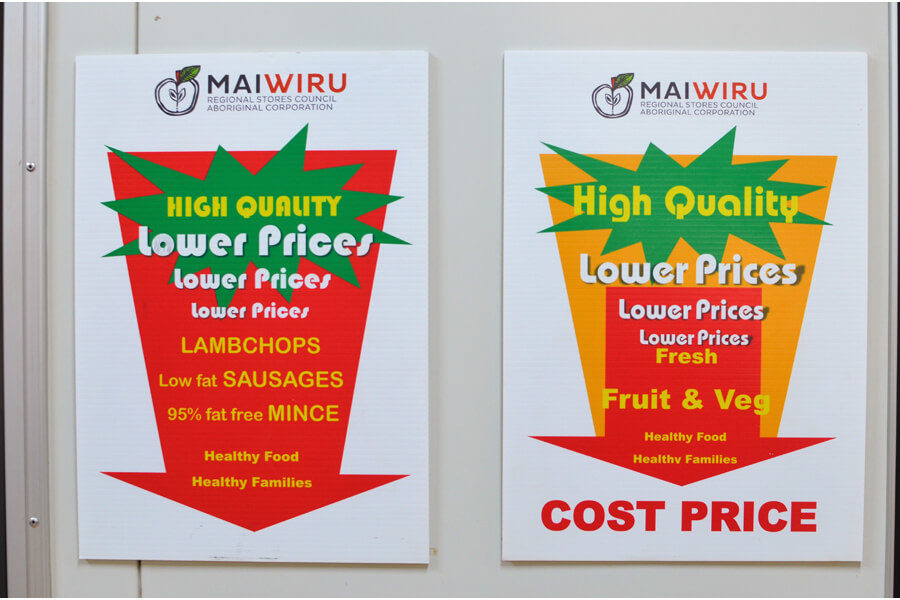Remote Aboriginal communities improve their food security and diet

DATE
TYPE Prevention Centre News
The 12-month project by Ngaanyatjarra Pitjantjatjara Yankunytjatjara (NPY) Women’s Council, Nganampa Health Council, Mai Wiru Regional Stores Aboriginal Corporation and the Prevention Centre targeted the availability, affordability, accessibility and promotion of healthy food.
Project researcher Professor Amanda Lee said previous research showed that the turnover of foods in what is usually the single store in remote Aboriginal communities was a good indicator of peoples’ dietary intakes, as validated against objective biomedical data. The results of this study also provide insights into broader nutrition issues affecting other Aboriginal communities and wider Australia.
“We have been assessing food security and dietary intake metrics to inform interventions on the APY Lands since 1986 and, despite everyone’s efforts, nutrition and diet-related health had been getting worse,” Professor Lee said.
“But since the communities introduced this concerted intervention in 2018, the stores we worked with have improved the number, range, quality and relative price of fresh fruits and vegetables, lean meats and wholegrain cereals, improved product placement and promotion, and provided healthy takeaways, to help make healthier choices the easiest choices.”
The research team worked with Mai Wiru Regional Stores and the communities to strengthen their store nutrition policy.
Project officer Rhiannon Hutchinson, a trained nutritionist, also worked with members of two specific communities, implementing a range of community-led interventions to increase demand for healthy food. This involved responding to any requests to help improve nutrition, including cooking, product demonstrations, budgeting, sessions for children and young people, recipe development and ‘bush picnics’.
She also worked closely with store managers to help implement the revised Mai Wiru store nutrition policy in these two communities, in a step-wise approach.
Multiple evaluation methods included assessment of store sales data, costs/affordability using the Healthy Diets ASAP (Australian Standardised Affordability and Pricing) methods, and store nutrition policy compliance. Non-intervention communities functioned as staged controls.
Importantly, the project took a strengths-based approach and built on traditional food knowledge. The main dietary message was to “eat store foods that are most like traditional bush foods”. All organisations worked with the communities to improve capacity, build on traditional nutrition knowledge and skills and build community demand for healthy foods.
During the intervention:
- Improvement in food security metrics were more marked in the stores in the two intervention communities where scores for product availability, product placement, and promotion increased respectively from 80% to 98%, from 64% to 92%, and from 54% to 100%.
- Improvement in diet was most marked in the community (Pipalyatjara) where both food supply and food demand strategies were in place the longest; the intake of fruit doubled (from 39g to 79g per person/day), the intake of vegetables increased (from 109g to 133g per person/day) and the intake of sugary drinks decreased by 5%. Reliance on bread as the main dietary source of energy decreased by 20%, suggesting less food stress.
- The average proportion of energy derived from unhealthy (discretionary) foods and drinks from all stores assessed was stable at 45% (compared to around 37% for non-Indigenous communities). However, at Pipalyatjara, the proportion of energy derived from unhealthy foods decreased to 39%.
- A healthy diet on the APY Lands became more affordable than an unhealthy diet, costing 15% less; the cost of fruit and vegetables was only 6% higher than in Alice Springs. Over the year, on the APY Lands, the cost of a healthy diet increased by about 2% and the cost of an unhealthy diet increased by 5%. In comparison, in Alice Springs the cost of a healthy diet increased by 7%, while the cost of an unhealthy diet increased by 5%.
The project was funded by the Medical Research Future Fund to address Aboriginal food security and dietary intake. Lack of food security – when all people, at all times, have physical, economic and social access to sufficient, safe, and nutritious food to meet their dietary needs and food preferences for an active and healthy life – is still a significant contributor to poor health in Aboriginal and Torres Strait Islander communities.
Professor Lee said the project confirmed that multi-strategy, community-lead nutrition projects focusing on both supply and demand could improve Aboriginal food security and diet rapidly and should be implemented nationally at scale.
“The stores in the two intervention communities now score almost 100% against all the metrics assessed. For example, they have moved sugary drinks fridges to the rear of the store, no longer stock large sizes of sugary drinks, and cross-subsidise the price of healthy choices, such as fresh produce, lean meats and water.
“The key was to work collaboratively to strengthen the store nutrition policy, monitor implementation regularly, feed results back to the communities, and support community demand for healthier options,” she said.
Working with remote communities who can intervene in their food system in a more contained manner than in less isolated communities has resulted in findings that can be applied more broadly to other Aboriginal communities and wider Australia.
For example, the project has shown that there is a direct relationship between product placement and promotion in food outlets and dietary intake. Results reinforce the notion that policy regulation and market intervention are required to improve food security and diet.



